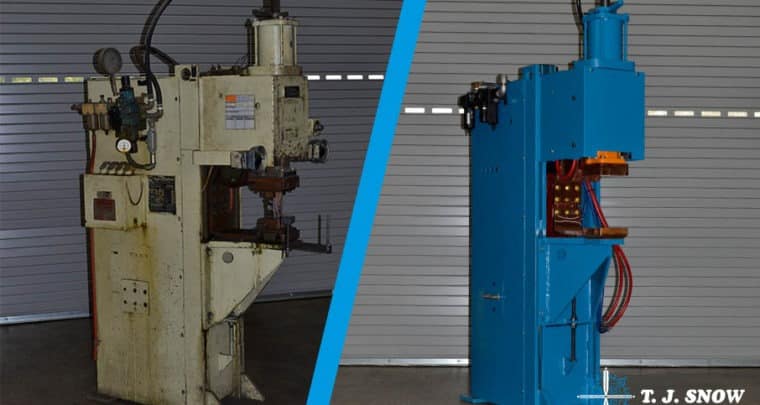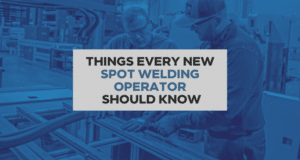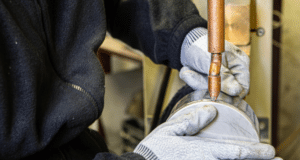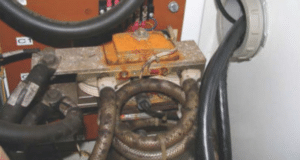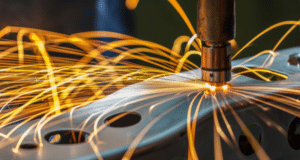By Tom Snow —
With light-duty “throw-away” industrial machinery being so common today, many well known brands of resistance welders from the last century are well worth the cost of remanufacturing and updating to new machine specifications.
“They don’t build ‘em like they used to” applies to resistance welders in particular because it takes a lot of expensive copper and steel to meet accepted “heavy duty” welding machine standards.
Due to the high secondary currents typically used in the resistance welding process, often in the range of 30,000 amps or more, many “veteran” US-made welder brands were designed with massive water cooled copper castings that are extremely expensive to produce today.
In addition, welder frames of the past were typically designed with heavier steel fabrications than are common today, leading to better rigidity when high forging forces are required.
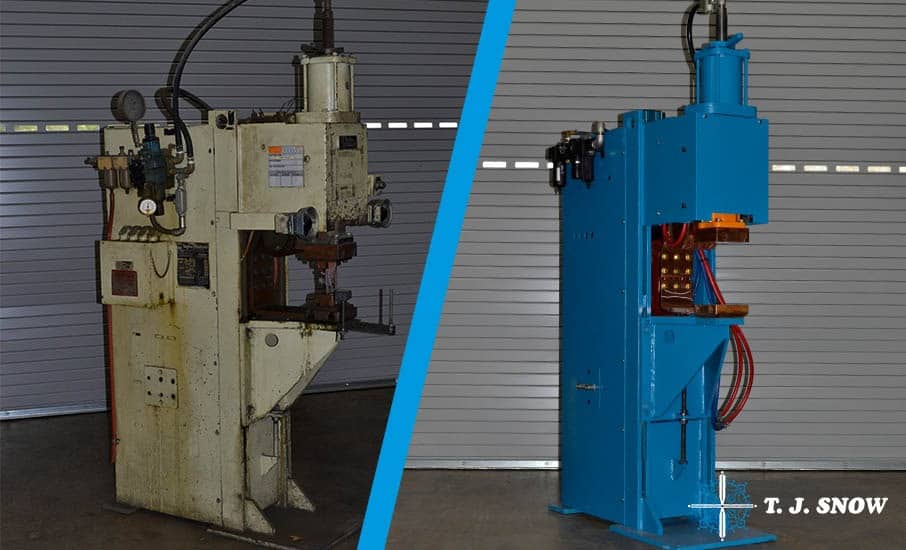
In the United States, the age of light duty press type and rocker arm resistance spot and projection welders began in the 1980s, when, as you would expect, Japanese automobile manufacturers and their Japanese-owned Tier 1 suppliers brought their resistance welding technology with them.
Japanese resistance welder designs had proven successful in their factories for many years, but the diminutive welders stood out in stark contrast to the larger, heavier-duty machines made by American welder manufacturers who conformed to the standards of a trade association then known as the Resistance Welder Manufacturers Association (RWMA), now the Resistance Welding Manufacturing Alliance, a standing committee of the American Welding Society.
To advertise a welder as meeting RWMA Standards, machines must meet certain minimum specifications for weld pressure (forging force) and secondary amperage (welding heat) as published in RWMA Bulletin 16. These variables in machine design are important because “Class A” resistance spot welds of maximum strength and optimum appearance cannot be produced without the proper input of amps and force.
As an example, a standard 100 KVA RWMA “Size 2” press-type spot welder with a relatively short 18” throat depth is required to have an air cylinder diameter large enough to produce at least two tons (4,000 pounds) of welding force at 80 PSI incoming air pressure. (Weld force requirements for longer throat depths are less.)
Similarly, an RWMA-standard 100 KVA transformer must be designed with copper windings and an electrolytic steel core large enough to produce a “short circuit” (tip-to-tip, without steel in the throat) secondary output of 31,000 amps at 50% duty cycle. Furthermore, a resistance welder’s secondary amperage reading should be measured RMS (root mean square), rather than the higher “peak” reading that is sometimes cited. It is the RMS or effective current on which welding schedules are based.
The specified duty cycle of a transformer is also important to note because KVA (kilovolt amps, a thermal rating), can be “inflated” by citing a lower duty cycle than this industry standard. As an example, the same resistance welding transformer rated 100 KVA at 50% duty cycle can be rated 224 KVA at 10% duty cycle.
This variable becomes especially critical when the weld heat time (current flow duration) of a resistance welding application approaches or exceeds the available cool time of the process. Exceeding a welder’s rated duty cycle can lead to poor weld strength, overheating of the machine, and eventual failure of the transformer.
New welders designed to RWMA standards are still available today, but it takes a discriminating buyer to appreciate the reasons why these machines are often two or three times the price of an imported welder of the “same” KVA rating.
This cost differential is why many “veteran” US-made resistance welders are prime candidates for Remanufacturing. Even machines made in the 50s are worth considering … and since a heavy duty used resistance welder can typically be remanufactured for about half the price of a comparable new machine, it’s usually a worthwhile investment. In addition, the reman of an existing welder may be considered a maintenance expense rather than a capital investment.
Among the most desirable heavy duty American-made resistance welder brands from years past are Taylor-Winfield, Federal, Precision, Progressive, Banner and Sciaky. However, some of those respected welder brands also offer light-duty models to compete with imports, so it’s important to understand the differences.
When choosing a resistance welder to remanufacture, look for one with as many of these features as possible:
- Heavy duty cast copper secondary conductors with water cooling circuits built in.
- Arms, electrode holders and all other secondary conductors made of copper (not less-conductive brass).
- Stacked-core resistance welding transformers with adequate water cooling circuits.
- Easily-accessible transformer tap switch with at least 6-8 steps of coarse heat regulation.
- In vertical-action press-type spot and projection welders, look for a roller-type or ball bearing ram design and avoid the quill-type metal-to-metal rams commonly used in lower-cost welders.
- Also relative to press-type welders — look for a machine with a fast-follow-up device built into the ram, such as a die spring or diaphragm-type air cylinder.
- Other desirable features include adjustable and retractable stroke air cylinders.
If you can’t decide between likely candidates to remanufacture, weigh the welders under consideration and choose the heaviest one. And for good results, use the suggested remanufacturing steps as outlined in the sidebar.
Due to significant advances in resistance welder control technology, plan on scrapping old, obsolete welder controls and investing in new ones.
If you’re willing to make the substantial investment to have the latest inverter-type Mid-Frequency Direct Current (MFDC) resistance welding technology, new MFDC transformers and controls can be retrofitted to “veteran” welder frames. This single-phase-AC to three-phase-DC conversion can provide significant power savings, along with higher secondary currents and a more controllable output.
In addition, there is a retrofit control now available that converts an existing AC resistance welder to Inverter Technology, including integral weld monitoring and adaptive feedback, and this retrofit package preserves the robust transformer design of a standard AC resistance welder.
Another relatively new welder control feature available is a “soft touch” option which improves operator safety.
Most light-duty imported resistance welders are not necessarily bad machine designs when applied properly, but it is important understand the significant differences when compared to heavy-duty used resistance welders that have been properly remanufactured and equipped with modern controls.
In conclusion, just like it’s not advisable to routinely haul a 1-ton load in a ½-ton truck, remember to choose the right welder for the job and consider getting new life out of old iron that was built to last.
SUGGESTED STEPS IN REMANUFACTURING A RESISTANCE WELDER
- Select a heavy duty welder design worth remanufacturing.
- Disassemble the machine completely, down to the last bolt.
- Pay attention to locations where electrical insulation materials and non-magnetic bolts are used and save them for re-use.
- Scrap the old control unless it is a current model with good vendor support.
- Sandblast and spray paint the frame.
- Clean all copper secondary connections and remachine mating surfaces as required for intimate contact. (See photo.)
- Check the transformer for shorted coils and internal moisture with a Megger (Megaohm) meter.
- Confirm that the water cooling lines of the transformer are not plugged.
- Send the transformer to a specialized repair facility if problems are found. (Most electric motor shops do not have the expertise to rewind resistance welder transformers.)
- Check for proper operation of the transformer’s multi-step tap switch and repair or replace as required.
- Remachine or replace worn parts, especially in the force delivery system of press welders and rocker arms.
- Reassemble the welder, using proper electrical insulation and non-conductive bolts per Item #3 above.
- Use a thin coat of “Copper Lube” or similar electrically conductive oxide inhibitor when reassembling all secondary copper connections.
- Rebuild or replace the air cylinder. Cylinders can often be replaced at relatively low cost. When rebuilding an air cylinder, use all new packings and a new cylinder wall, if required.
- Install a new FRL (filter, regulator, lubricator & gauge).
- Install an entirely new water cooling system, including hoses, manifolds, water flow indicators and a water flow switch.
- For good water flow to all components, run water circuits in parallel, not series.
- Test the machine to new welder specifications.
Tom Snow is a chairman of T. J. Snow Company, Chattanooga, TN, an RWMA member. T. J. Snow has been remanufacturing resistance welders for over 50 years.

